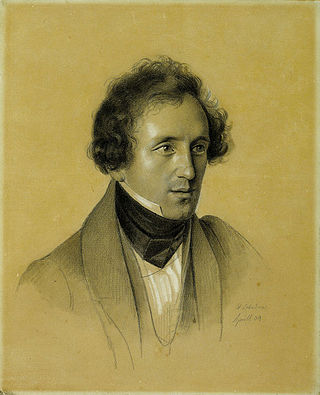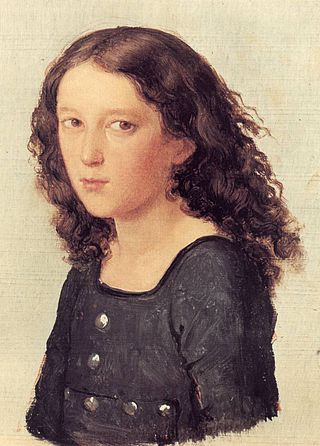
Felix Mendelssohn's Violin Concerto in E minor, Op. 64, MWV O 14, is his last concerto. Well received at its premiere, it has remained among the most prominent and highly-regarded violin concertos. It holds a central place in the violin repertoire and has developed a reputation as an essential concerto for all aspiring concert violinists to master, and usually one of the first Romantic era concertos they learn. A typical performance lasts just under half an hour.

Mendelssohn's Piano Concerto No. 1 in G minor, Op. 25, was written in 1830–31, around the same time as his fourth symphony ("Italian"), and premiered in Munich on 17 October 1831. This concerto was composed in Rome during a travel in Italy after the composer met the pianist Delphine von Schauroth in Munich. The concerto was dedicated to her. Mendelssohn attended one party after another in Munich in October 1831, the month of the premiere, but he also played chamber music and taught double counterpoint. He performed the piece himself at the premiere, which also included performances of his Symphony No. 1 and the Overture from Midsummer Night's Dream. He had already written a piano concerto in A minor with string accompaniment (1822) and two concertos with two pianos (1823–24).
Songs Without Words is a series of short lyrical piano works by the Romantic composer Felix Mendelssohn written between 1829 and 1845. His sister, Fanny Mendelssohn, and other composers also wrote pieces in the same genre.

The String Octet in E-flat major, Op. 20, MWV R 20, was written by the 16-year-old Felix Mendelssohn during the fall of 1825 and completed on October 15. Written for four violins, two violas, and two cellos, this work created a new chamber music genre. Conrad Wilson summarizes much of its reception ever since: "Its youthful verve, brilliance and perfection make it one of the miracles of nineteenth-century music." This was one of the first works of Mendelssohn to be very well received.

Symphony No. 1 in C minor, Op. 11, is a work by Felix Mendelssohn, completed on 31 March 1824, when the composer was only 15 years old. The autograph score was published in 1831.

The Piano Concerto No. 2 in D minor, Op. 40, was written in 1837 by Felix Mendelssohn and premiered at the Birmingham Festival on 21 September that year, an event that also saw the premiere of Mendelssohn's oratorio St. Paul. He had already written a piano concerto in A minor with string accompaniment (1822), two concertos with two pianos (1823–4), and his first Piano Concerto. The concerto is about 25 minutes in length, and is scored for solo piano, 2 flutes, 2 oboes, 2 clarinets, 2 bassoons, 2 horns, 2 trumpets, timpani, and strings.
The String Quartet No. 2 in A minor, Op. 13, was composed by Felix Mendelssohn in 1827. Written when he was 18 years old, it was, despite its official number, Mendelssohn's first mature string quartet. One of Mendelssohn's most passionate works, the A minor Quartet is one of the earliest and most significant examples of cyclic form in music.

Felix Mendelssohn's Piano Trio No. 1 in D minor, Op. 49, was completed on 23 September 1839 and published the following year. The work is scored for a standard piano trio consisting of violin, cello and piano. It is one of Mendelssohn's most popular chamber works and is recognized as one of his greatest along with his Octet, Op. 20. During the initial composition of the work, Mendelssohn took the advice of fellow composer Ferdinand Hiller to revise the piano part. Hiller wrote, "with his usual conscientious earnestness when once he had made up his mind, he undertook the length and rewrite the whole pianoforte part."

The Piano Trio No. 2 in C minor, Op. 66, was written by Felix Mendelssohn in 1845 and published in February 1846. The work is scored for a standard piano trio consisting of violin, cello and piano. Mendelssohn dedicated the work to his close friend and violinist, Louis Spohr, who played through the piece with the composer at least once.

Piano four hands is a type of piano duet involving two players playing the same piano simultaneously. A duet with the players playing separate instruments is generally referred to as a piano duo.
Felix Mendelssohn's Sextet in D major, Op. 110, MWV Q 16, for piano, violin, two violas, cello, and double bass was composed in April–May 1824, when Mendelssohn was only 15, the same time he was working on a comic opera Die Hochzeit des Camacho. Its composition took place between the Viola Sonata and the Piano Quartet No. 3. It also preceded the famous Octet, Op. 20 by about a year. 1824 is also the probable year of the composition of the Clarinet Sonata. Like the latter, the Sextet was not published during the composer's lifetime. Its first edition was issued in 1868 as a part of a complete collection of Mendelssohn's works, hence the misleadingly high opus number.
Felix Mendelssohn's Cello Sonata No. 1 in B-flat major, Op. 45 was composed in October 1838.
Felix Mendelssohn's Cello Sonata No. 2 in D major, Op. 58, was composed in late 1842 — first half of 1843. The main theme of the first movement is a reworking of an unrealised Piano Sonata in G major. The Cello Sonata, which was dedicated to the Russian/Polish cellist Count Mateusz Wielhorski, has four movements:
- Allegro assai vivace
- Allegretto scherzando
- Adagio
- Molto allegro e vivace
Felix Mendelssohn's Piano Quartet No. 2 in F minor, Op. 2, for piano, violin, viola and cello was published in 1823, a year after his first Piano Quartet No. 1 in C minor, Op. 1. This work was dedicated to Carl Friedrich Zelter, who became Mendelssohn's composition and music tutor starting at the age of eight years old. Zelter would take Mendelssohn on trips to go see Johann Wolfgang von Goethe, who was also an important figure in Mendelssohn's life when it came to the composition of his earliest pieces between the years 1821-1825. Mendelssohn's three piano quartets were the first piano quartets he composed and published. He composed the second quartet at the age of only 14 years.
Felix Mendelssohn began composing his Piano Quartet No. 3 in B minor, Op. 3, for piano, violin, viola and cello in late 1824 and completed it on 18 January 1825, just before his sixteenth birthday. The quartet was published later that year and was dedicated to Goethe whom Mendelssohn had met a few years earlier. Mendelssohn's three numbered piano quartets were the first works of his to be published, hence their opus numbers.

The Fantasia in F minor by Franz Schubert, D.940, for piano four hands, is one of Schubert's most important works for more than one pianist and one of his most important piano works altogether. He composed it in 1828, the last year of his life. A dedication to his former pupil Caroline Esterházy can only be found in the posthumous first edition, not in Schubert's autograph.

Variations sérieuses, Op. 54, MWV U 156, is a composition for solo piano by Felix Mendelssohn consisting of a theme in D minor and 17 variations. It was completed on 4 June 1841. A typical performance lasts about eleven minutes.

The Concerto for Piano, Violin, and Strings in D minor, MWV O4, also known as the Double Concerto in D minor, was written in 1823 by Felix Mendelssohn when he was 14 years old. This piece is Mendelssohn's fourth work for a solo instrument with orchestral accompaniment, preceded by a Largo and Allegro in D minor for Piano and Strings MWV O1, the Piano Concerto in A Minor MWV O2, and the Violin Concerto in D minor MWV O3. Mendelssohn composed the work to be performed for a private concert on May 25, 1823 at the Mendelssohn home in Berlin with his violin teacher and friend, Eduard Rietz. Following this private performance, Mendelssohn revised the scoring, adding winds and timpani and is possibly the first work in which Mendelssohn used winds and timpani in a large work. A public performance was given on July 3, 1823 at the Berlin Schauspielhaus. Like the A minor piano concerto (1822), it remained unpublished during Mendelssohn's lifetime and it wasn't until 1999 when a critical edition of the piece was available.
A concert piece is a musical composition, in most cases in one movement, intended for performance in a concert. Usually it is written for one or more virtuoso instrumental soloists and orchestral or piano accompaniment.
Kristin Merscher is a German classical pianist and professor at the Hochschule für Musik Saar in Saarbrücken, Germany.









